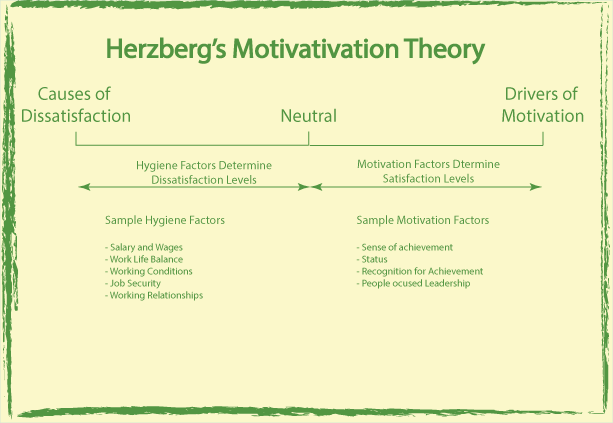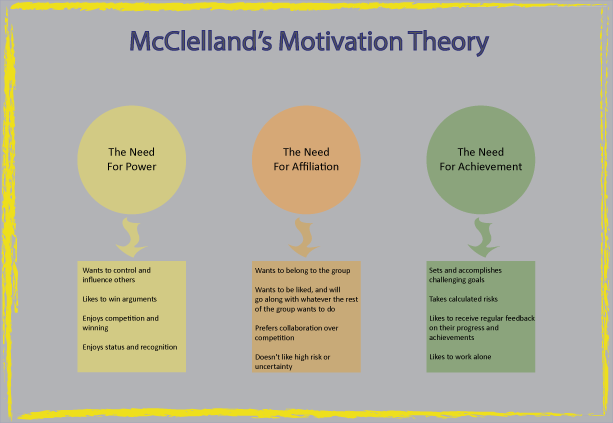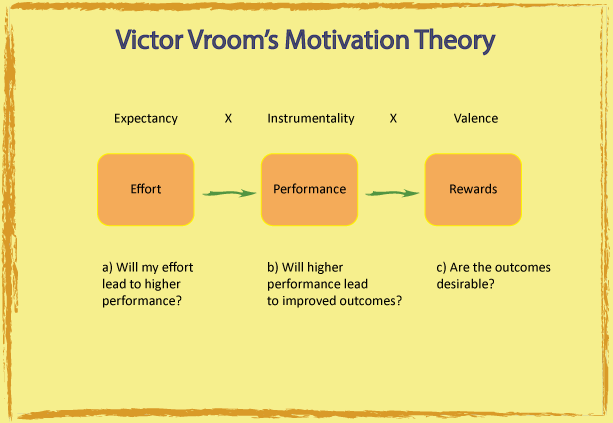Employee Motivation
For High Employee Engagement
Employee motivation is the responsibility of their leader, your leadership effectiveness is ultimately measured by the performance of your team. If your team achieves high performance and high employee engagement then you are a good leader.
High employee engagement does not just happen by itself. Employees are engaged when their leader creates an environment which motivates them to be engaged.
Leaders who have a solid understanding of motivation theory and how each theory impacts on employee engagement are well placed to achieve high employee engagement in their business.
Now, let’s take a look at how employee motivation theories can be applied to your workplace to engage your employees.

Herzberg’s Employee Motivation Theory
The foundation for employee motivation is nested in Herzberg’s theory of motivation as it draws a sharp distinction between those things that cause dissatisfaction and those things that drive motivation in the workplace.
This theory suggests that removing a source of dissatisfaction from your team’s work environment will reduce dissatisfaction, however will not increase motivation. The same can be said for introducing something to improve motivation; it will not reduce any dissatisfaction.

Some examples of hygiene factors include
- Company policies
- Working conditions
- Salary
- Relationship with supervisor
- Security
- Status
Some examples of motivation factors include
- Achievement
- Recognition
- Responsibility
- Challenging work
- Opportunities for advancement
Herzberg and Employee Engagement
If your organisation participates in employee engagement surveys you will probably facilitate workshops with staff to identify areas where you can improve your teams engagement.
Once you have a list of employee suggestions you can evaluate the list and categorise each action as either resolving a “Cause of Dissatisfaction” or being a “Driver of Employee Motivation”.
If the majority of employee suggestions are resolving a “Cause of Dissatisfaction” fixing them may not result in a highly engaged workforce, it will simply result in a less dissatisfied workforce. In this case you should try again and seek ideas on how to improve motivation in the workplace.
Maslow’s Theory of Employee Motivation
Maslow developed a hierarchy of needs consisting of five needs starting with lower order needs such as shelter and food and moving up through security, belonging and esteem and finishing with self actualisation.
Maslow theorised that these needs must to be satisfied in order. People will be driven to satisfy their physiological needs of air, food, water and shelter before they will consider their need for safety and security. Once these needs are satisfied people will look to satisfy their love/belonging needs and then their self-esteem needs. As each need is satisfied in the hierarchy the person will then seek to fulfil the next level need.

Maslow and Employee Engagement
During your planning to improve employee engagement you can assess your list of planned actions to determine which of Maslow’s needs these actions are aiming to address. If your actions include social functions, team lunches then you may be targeting Maslow’s love/belonging need.
Whilst this will improve employee satisfaction and may reduce turnover it may not have a great impact on employee engagement.
To achieve high performance through high employee engagement your list of employee engagement improvement actions needs to address Maslow’s high level needs of esteem and self-actualisation.
The drivers of high performance are a set of leadership behaviours that target Maslow’s higher order needs and have been proven through research to build a high performance team.
McClelland’s Needs Theory for Employee Motivation
McClelland needs theory differs from Maslow’s needs theory; where Maslow’s theory focuses on the sequence in which people will seek to satisfy their basic needs, McClelland identified that all people also have different motivational needs.
McClelland proposed that all people have to varying extents three motivational needs
- Power – the need to be in charge and to win
- Affiliation – the need to belong to a group
- Achievement – the need to set and accomplish goals

McClelland and Employee Engagement
When creating your engagement action plans you will find that the people with a high need for affiliation will prioritise different activities, (team social functions) for the team than those with high need for power (competitions) or a high need for achievement (setting goals).
The person with a high need for achievement is more likely to take an action and work on it alone reporting status back to the group, whilst the person with a high need for affiliation will want to set up a committee to work on the action.
To achieve high employee engagement and high employee motivation you need to allow each person to be authentic to his or her needs.
Skinner’s Classical & Operant Conditioning
Skinner is a behavioural psychologist who proposed that people are motivated to repeat a behaviour that received a positive outcome (Positive Reinforcement) and will stop a behaviour that has a negative outcome (Negative Reinforcement).
Further the theory added in the frequency or time interval with which the behaviour lead to an outcome also influenced the probability of a behaviour being repeated or stopped.
For example if you get a speeding fine (punishment) once every one thousand times you speed you may not adjust your behaviour however if you were to get a fine more often you may adjust your behaviour. (Also if the fine is so small that it does not impact you then it is not an effective form of punishment.)
Skinner found that if the interval for reinforcement of behaviour was random and the reward was also random in size then your people would have greater motivation to repeat the behaviour. Hence the addictive nature of poker machines; they at a random interval payout a random size reward, which is the strongest motivation paring for reinforcement and interval.
If you want a behaviour to stop you will have greater success if you punish every instance of the behaviour, if you only punish the behaviour once per year in a performance review it is unlikely the behaviour will ever change.

Classical and Operant Conditioning and Employee Engagement
To achieve a highly engaged team you will need to be consistent with punishment and meter out consequences for each instance of undesirable behaviour, however you will also need to give positive feedback at random intervals for high performance and good contribution.
Victor Vroom’s Expectancy Theory
Victor Vroom identified that people are motivated to do work based on their perception of the outcome that they will get for doing the work (Job security, promotion, recognition) however all employees place different levels of importance on the outcome.
For example: if the outcome for good work is job security you may find that someone close to retirement may place less importance on job security than someone with a young family, as a result the older person will be less motivated by an outcome of job security.
Further Victor Vroom identified that if the perceived outcome is the same for all levels of performance (which is common) then your people will not be motivated to achieve.

Expectancy Theory and Employee Engagement
From a leadership perspective you need to ensure that the outcome is different for different levels of employee performance. (High performing employees get opportunities for advancement; low performing employees get performance discussion) You also need to ensure that your employees desire the outcome you have on offer.
Desirable outcomes Victor Vroom links to McClelland:
For someone with a high need for achievement a desirable outcome could be challenging assignments as a reward for high performance, for people with a high need for affiliation a desirable outcome could be a social reward for high performance - which could be as simple as sitting closer to the people that they like, and for people with a high need for power a desirable outcome could be to run a competition in the team.
Adman’s Equity Motivational Theory
Through his equity theory Adams proposes that employees are motivated when they perceive that fairness exists; people are generally happy when they believe they are treated fairly.
Equity and Employee Engagement
The challenge for a leader is that employees are not motivated by your perception of fairness they are motivated by their perception of fairness. If an employee perceives that another employee is getting preferential treatment then the employee’s motivation will decline simply because in their mind the environment lacks fairness.
Frequent formal feedback and discussion sessions such as monthly one on ones will assist greatly in ensuring a perception of fairness, as will making sure that you as the leader are aware of any bias impacting on fairness that you may have.
Motivation For Change
Imagine your team perceive an absence of fairness, their needs are not being met and there is more negative reinforcement that positive reinforcement. How will you go trying to implement change in this environment?
Creating a change ready organisation is about improving employee motivation, employee engagement and leadership capabilities to ensure the team are positive, you will then find that creating and implementing change is a lot easier.
Employee Motivation Summary
Employee engagement is measured in organisations because there is a strong correlation between employee engagement and overall business performance. The employee engagement score that you receive is a proxy measure of your leadership effectiveness.
Improving employee engagement by running workshops with your staff to develop actions is a common practice, however it does not always result in an increase in the level of engagement in your business.
Improving employee engagement will occur if you have a balanced plan that removes some causes of dissatisfaction and addresses employee motivation. It is good practice to assess your employee engagement action plans to ensure the motivational need of your employee will be met.
Your action plan does not have to be long; it only needs to have the right few things on it for you to be successful. Don’t waste your time on actions that will not improve employee engagement.
Ian Pratt runs 6-8 week transformational sprints where leaders are coached each week with these leaders improving employee engagement significantly in that 6-week time frame and sustaining this level of employee engagement. To find out more click here.